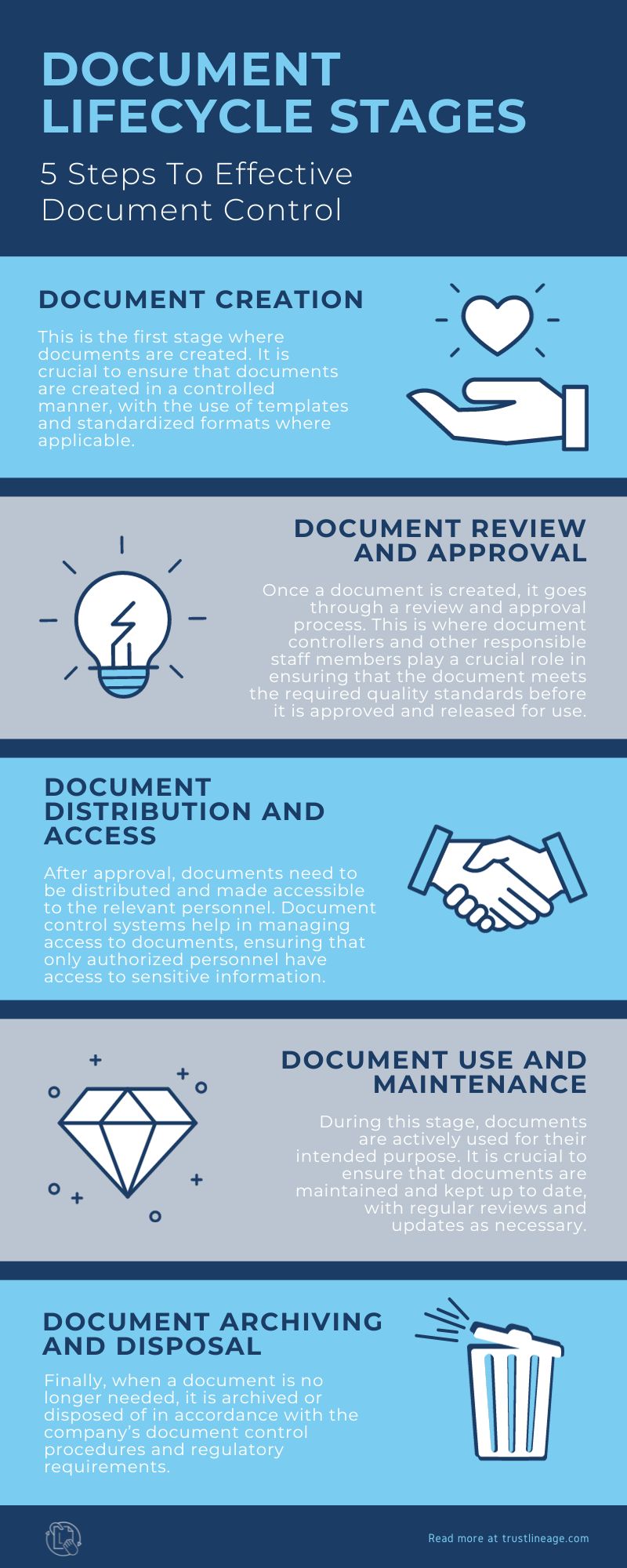The Best Document Control System Set Up Process For Businesses
Mastering the Art of Document Control
Have you ever found yourself rummaging through a pile of documents, feeling utterly lost? Or perhaps you’ve experienced the frustration of working on an outdated document only to realize it much later? In this post, we’re going to unravel the mysteries of setting up an efficient document control system, a process that can transform the way you handle your business documents. By the end of this read, you’ll be armed with knowledge and strategies to streamline your document management, ensuring that every piece of information is right at your fingertips, up-to-date, and secure.

How To Set Up A Document Control System
Step 1: Document Creation and Categorization
Initiating the document control process begins with the meticulous task of document creation. This is a critical stage where each document is crafted with precision, ensuring that all necessary information is included and accurately presented. It’s imperative to assign responsible staff members to oversee this process, guaranteeing that each document meets the organization’s quality standards.
During this phase, categorizing documents is equally important. This involves identifying various document types and classifying them accordingly. Whether they are design documents, legal contracts, or internal memos, each document type requires a unique approach to management. Utilizing document control software at this stage can significantly aid in streamlining this process, providing a central repository for all documents and ensuring that they are categorized in a controlled manner.
Step 2: Establishing Quality Standards and Approval Processes
Following document creation, the next step is to establish stringent quality standards and approval processes. This is where the organization defines what an acceptable document looks like, setting the stage for consistency and accuracy across all documents.
Implementing a standard operating procedure (SOP) is crucial at this stage, as it provides a clear guideline for document controllers and other responsible staff members on how to manage and approve documents. The SOP should outline the criteria that each document must meet before it is considered approved, ensuring that only documents that meet the highest standards are circulated within the organization.
Step 3: Naming Conventions and Document Storage
With quality standards in place, the next step is to establish clear naming conventions and document storage protocols. This is a vital component of the document control process, as it ensures that documents are not only stored securely but are also easily retrievable when needed.
Creating a consistent naming convention for all documents aids in avoiding confusion and ensures that every document is easily identifiable. This, coupled with secure document storage solutions, ensures that critical documents are protected from unauthorized access, maintaining the integrity of the organization’s data security.
Step 4: Creating Revision Procedures
Implementing comprehensive revision procedures is a pivotal step in the document control process, ensuring that all documents remain up to date and that they reflect the most current information.
Establishing Clear Revision Responsibilities
Assigning clear responsibilities for document revisions is crucial. This task typically falls to document controllers or document control specialists, who oversee the entire lifecycle of a document. They ensure that every change made to a document is necessary, properly executed, and fully documented.
Maintaining a Record of Changes
An effective document control system ensures that a complete record of all changes made to a document is maintained. This includes who made the change, when it was made, and what was changed. This level of transparency is essential for maintaining the integrity of the document and is a critical component of ensuring version control.
Ensuring Version Control
Version control is a fundamental aspect of managing documents efficiently. It ensures that everyone in the organization is working with the most current and accurate version of a document. Implementing a document management system that includes robust version control capabilities is vital for maintaining control over document revisions and preventing the confusion that can arise from working with outdated documents.
Step 5: Managing Access and Security
Ensuring that sensitive documents are protected and that access is controlled is a critical component of document control management.
Implementing Access Control
Access control ensures that only authorized personnel have access to sensitive documents. This is particularly important for maintaining data security and preventing unauthorized access that could lead to data breaches or security breaches.
Establishing a Backup System
In addition to controlling access, establishing a reliable backup system is crucial for protecting documents from loss due to unexpected events. This is an essential step in managing documents and ensuring that they are available when needed, even in the event of a system failure or other unforeseen circumstances.
Step 6: Archiving and Disposal of Obsolete Documents
The final step in the document control process is ensuring that obsolete documents are properly archived or disposed of, maintaining the accuracy and relevance of the document control system.
Implementing Archiving Procedures
Implementing clear and consistent archiving procedures ensures that obsolete documents are removed from active use but are still available if needed for reference or regulatory compliance purposes.
Ensuring Proper Disposal
When documents are no longer needed, even for archival purposes, ensuring their proper disposal is crucial. This includes not only the physical or electronic disposal of the document but also the removal of any references to the document in the document control system.

Document Control Procedures
Document control is a systematic approach to managing and controlling documentation within an organization. It encompasses a variety of processes and procedures that ensure all documents are created, reviewed, and approved in a controlled manner.
Document Creation
The document creation process is the first step in the document control journey. It involves defining the purpose of the document, identifying the responsible staff members for creating and approving the document, and establishing the document type. This process ensures that every document serves a specific purpose and is created with precision and accuracy.
Document Review
Once a document is created, it undergoes a rigorous review process. This process is crucial for ensuring that the document is accurate, relevant, and complies with the organization’s processes and regulatory requirements. The document review process often involves multiple stakeholders, including document controllers, subject matter experts, and legal advisors, especially in industries like law firms where legal significance is paramount.
Document Approval
After a document has been reviewed and any necessary revisions have been made, it moves on to the approval process. This is a critical step in the document control process, as it ensures that all the information in the document is correct and that the document meets all necessary standards and regulatory guidelines. The approval process typically involves senior management or other authorized personnel and may also include the use of electronic signatures to expedite the process and ensure a secure and verifiable approval.

Why Document Control is Crucial for Small Businesses
In the fast-paced business world, small businesses must adopt effective document control processes to stay competitive and enhance operational efficiency. Document control is pivotal for efficient document management, ensuring version control, regulatory compliance, and data security.
Working with Current Documents
Ensuring that employees are always working with the most up-to-date documents is essential to maintain accuracy and reliability within the organization. An effective document control system ensures the prompt removal or archiving of outdated documents, making the most current version always accessible to those who need it.
Access Control and Security
With the increasing amount of sensitive data handled by businesses, securing this information is paramount. Document control systems manage access to sensitive documents, ensuring only authorized personnel can access critical documents. This protects sensitive data from unauthorized access, preventing data breaches and security breaches.
Archiving and Version Approval
Proper archiving practices and version approval processes are crucial components of document control. They ensure the proper disposal of obsolete files and provide a controlled manner for approving and implementing document changes. This maintains the integrity of the document control system, allowing the business to operate more efficiently and cost-effectively.
Efficiency and Competitive Ability
Implementing a document control system enhances operational efficiency and competitive ability. It streamlines processes, reduces operational costs, and improves overall performance. Additionally, having a scalable document control system in place ensures the business can adapt and grow without being hindered by inefficient document management practices.

Advantages of an Effective Document Control System
Quick Access & Accuracy
- Effortless Retrieval: Swiftly find necessary documents without sifting through paperwork or complex digital folders.
- Minimized Errors: Drastically cut down errors from using outdated or incorrect documents, ensuring accurate business operations and decision-making.
Cost Efficiency & Streamlined Workflows
- Automated Management: Automate tasks like version and access control and document approval, slashing operational costs and boosting efficiency.
- Space & Cost Savings: Cloud-based systems reduce the need for physical storage, contributing to further cost reductions.
Enhanced Security & Regulatory Adherence
- Robust Protection: Safeguard sensitive documents from unauthorized access, with all interactions logged for audit purposes.
- Simplified Compliance: Automate compliance tasks and maintain a complete audit trail, ensuring adherence to regulatory guidelines.
Quality Improvement & Customer Satisfaction
- Quality Assurance: Maintain up-to-date, approved documents accessible for higher quality outputs and improved task performance.
- Boosted Customer Satisfaction: Deliver products and services that meet or surpass client expectations, enhancing customer relations.

What is Document Control Software?
Document control software is a specialized tool designed to manage and control the documentation process within an organization. It plays a crucial role in ensuring that documents are created, reviewed, approved, and archived in a controlled and efficient manner.
Role of Document Control Software
Document control software serves as a central repository for all documents, making it easy for employees to find and access the information they need. It automates many of the tasks associated with document control, including version control, access control, and the approval process. This not only saves time but also ensures that the process is carried out consistently and accurately, reducing the chances of errors.
Importance of Centralized, Cloud-Based Solutions
In today’s digital age, having a centralized, cloud-based document control solution is more important than ever. Such solutions offer numerous advantages over traditional, paper-based systems, including the ability to access documents from anywhere at any time. This is particularly beneficial for businesses with remote or distributed teams, as it ensures that all employees have access to the same information, regardless of their location. Additionally, cloud-based solutions offer enhanced security features, ensuring that sensitive documents are protected from unauthorized access.
Understanding Document Control
Document control is a systematic approach to managing and controlling company documents throughout their lifecycle, from creation to archiving or disposal. It plays a critical role in ensuring the accuracy, reliability, and integrity of business information, making it an indispensable part of quality management systems.
This process is vital for businesses as it ensures that employees are always working with the most up-to-date and accurate information, which is crucial for maintaining the quality of products and services, as well as ensuring regulatory compliance.
Impact on Productivity, Quality, and Compliance
Implementing a document control system enhances productivity by reducing the time spent searching for documents and ensuring that employees have quick access to the information they need. It also improves the quality of work as it ensures that all work is based on the latest and most accurate information. In terms of compliance, document control plays a crucial role in ensuring that businesses adhere to industry standards and regulatory requirements, reducing the risk of non-compliance and associated penalties.

Document Control System Lifecycle
A document control system goes through various stages during its lifecycle, from the creation of documents to their eventual archiving or disposal.
Lifecycle Stages
The lifecycle of a document control system can be broken down into several stages:
- Document Creation: This is the first stage where documents are created. It is crucial to ensure that documents are created in a controlled manner, with the use of templates and standardized formats where applicable.
- Document Review and Approval: Once a document is created, it goes through a review and approval process. This is where document controllers and other responsible staff members play a crucial role in ensuring that the document meets the required quality standards before it is approved and released for use.
- Document Distribution and Access: After approval, documents need to be distributed and made accessible to the relevant personnel. Document control systems help in managing access to documents, ensuring that only authorized personnel have access to sensitive information.
- Document Use and Maintenance: During this stage, documents are actively used for their intended purpose. It is crucial to ensure that documents are maintained and kept up to date, with regular reviews and updates as necessary.
- Document Archiving and Disposal: Finally, when a document is no longer needed, it is archived or disposed of in accordance with the company’s document control procedures and regulatory requirements.
Roles and Responsibilities
Document controllers and document control specialists play a crucial role in managing the document control system, ensuring that documents are created, reviewed, approved, and maintained in a controlled manner. They are responsible for classifying documents, managing access, and ensuring that documents are archived or disposed of in accordance with company procedures and regulatory guidelines.

Achieving Efficiency in Document Control Systems
For a document control system to be effective, it needs to be efficient. This means ensuring that documents are managed in a way that is streamlined, user-friendly, and cost-effective.
Strategies for Efficiency
To achieve efficiency in document control systems, businesses can employ various strategies, such as automating document control processes, implementing cloud-based document control software, and providing training to employees on how to use the system effectively.
Role of Automation
Automation plays a crucial role in enhancing the efficiency of document control systems. By automating tasks such as document review, approval, and distribution, businesses can reduce the time and effort required to manage documents, leading to increased productivity and operational efficiency.
Features of an Ideal Automated Document Control System
An ideal automated document control system should offer features such as version control, access control, audit trails, and integration with other business systems. These features contribute to a streamlined and efficient document control process, ensuring that documents are managed in a controlled and consistent manner.

Importance of Document Control
Document control is a critical aspect of any organization’s operations, ensuring that all essential documents are kept up-to-date, secure, and accessible to authorized personnel. It plays a vital role in maintaining data security and in preventing data breaches and security breaches that could have severe legal and financial repercussions.
By ensuring regulatory compliance, document control systems help in navigating the complex landscape of regulatory guidelines, ensuring that the organization is always in line with the latest requirements. This not only helps in avoiding potential legal issues but also contributes to operational efficiency, as well-organized document control processes streamline business processes and reduce operational costs.
In the long run, investing in an effective document control system ensures control and power over your business information, yielding long-term returns in quality, efficiency, and security.
Document Control Strategies
Documenting Quality Standards: Start by establishing and documenting your quality standards and creating comprehensive Standard Operating Procedures (SOPs). This sets a clear benchmark for quality and ensures consistency across all documents.
Managing Obsolete Documents: Implement procedures to regularly review and manage obsolete documents. This ensures that all the documents in use are up-to-date and relevant, reducing confusion and maintaining accuracy.
Training Management: Ensure that all responsible staff members are adequately trained in document control procedures. This guarantees that everyone is on the same page and understands the importance of proper document management.
Classifying Documents: Develop a system to classify documents based on their type, purpose, or department. This makes it easier to locate specific documents and manage them more effectively.

Benefits of Document Control
- Streamlined Access and Reduced Errors: Implementing a document control system leads to organized and efficient document access, significantly reducing the likelihood of errors.
- Cost Savings and Operational Efficiency: By managing documents efficiently, operational costs are cut down, leading to smoother business processes and financial savings.
- Enhanced Data Security and Compliance: Document control systems ensure that sensitive data is protected and that the organization is in compliance with regulatory requirements, reducing the risk of legal issues.
- Improved Quality and Customer Satisfaction: With a document control system in place, the quality of work is enhanced, leading to higher customer satisfaction and better business outcomes.
Transform Your Document Management with Lineage
You’ve just navigated through the essentials of setting up a robust document control system, understanding its critical components, and ensuring compliance and efficiency across your organization.
Lineage is here to support you in implementing these practices with our advanced document management systems. We provide the tools and expertise needed to streamline your document control processes, ensuring that every document is accounted for, secure, and easily accessible.
Ready to elevate your document management game? Reach out to us—fill out our contact form or give us a call today. Let Lineage empower your business with top-notch document control solutions!
